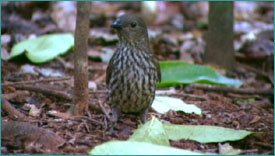Bowerbirds: Nature's Interior Designers
Biology 342 Fall 07
Valerie Conrad and Hannah Smith
Mechanism
The Production of a Bower
Due to the high degree in which spatial knowledge, memory, and creativity figure into bower building, investigation into correlations between brain size and bower construction has been a popular area of study. Because only mature male birds are able to construct bowers, and the possesion of one is a vital mating display, the hormonal component of bower building has also been an area of inquiry. It is possible that other mechanisms are involved, leaving open many other research opportunities.
Brain size has been the focus of studies examining differences in bower complexity. Bower-building birds show increased brain size when compared to non-bower-building birds, and within the bowerbird family, more complex bowers are also associated with larger brains. The similarities in bowerbird species' habitats, feeding behaviors and development, among other factors, increase the likelihood that differences in brain size are associated strongly with differences in bower construction (Madden 2001).
In investigating which areas contribute to the increased brain size, a significant relationship was found between cerebellum size and bower complexity, in addition to finding general enlargement of the entire brain and telencephalon relative to non-bower-building catbirds.This suggests a connection between cerebellum-specific functions and the skills used to construct a bower. The cerebellum has been found to play an important role in motor skills and procedural learning-- skills that do appear necessary for the precise placement of objects that often distinguishes a successful bower builder (Day et. al.).
 [5]
[5]
The mechanism of bower building also appears to have a hormonal component. Bower-holdng birds demonstrate significantly higher levels of testosterone than non-bower-holding birds. Bower-holding birds tend to be older than non-bower-holding birds, but no correlation between absolute age and testosterone levels was found. In addition, a positive correlation between testosterone and bower quality has been shown, with bower quality being measured by bower symmetry, stick size, stick density and overall quality of construction. Higher quality bowers are favored by females, and thus, birds with higher levels of testosterone experience higher levels of mating success.
However, when juveniles were implanted with testosterone, they did not experience an increase in the quality of their displays, though they did demonstrate increased aggression toward other juveniles. In adult birds, no correlation was found between aggression and testosterone. Levels of corticosterone were also assessed, with a major finding being that corticosterone levels decreased with increased display behavior. This inverse relationship contradicts the belief that displaying is stressful and thus costly. These findings support the hypothesis that learning plays a major role in successful displays, but also suggest that testosterone levels enable the expression of these behaviors, especially as testosterone is not prevalent in female birds (Borgia and Wingfield).